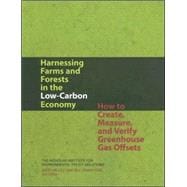
Note: Supplemental materials are not guaranteed with Rental or Used book purchases.
Purchase Benefits
What is included with this book?
| Foreword | p. vii |
| Preface | p. ix |
| Overview | |
| Introduction: The Role of Landowners and Farmers in the New Low-Carbon Economy | p. 3 |
| The Process of Creating Offsets | p. 10 |
| Land-Management Options for Creating Offsets | p. 22 |
| Steps in Determining a Project's Offsets | |
| Step 1: Scoping the Costs and Benefits of a Proposed Project | p. 39 |
| Step 2: Determining Additionality and Baselines | p. 46 |
| Step 3: Quantifying the Carbon Sequestered in Forests | p. 52 |
| Step 4: Quantifying the Carbon Sequestered in Soil | p. 64 |
| Step 5: Quantifying Greenhouse Gas Emissions from Manure | p. 75 |
| Step 6: Quantifying and Minimizing Methane and Nitrous Oxide Emissions from Soil | p. 84 |
| Step 7: Estimating Leakage or Off-Site Emissions Caused by the Project | p. 91 |
| Step 8: Verifying and Registering Offsets | p. 99 |
| Conclusion: Putting These Guidelines into Practice | p. 107 |
| Appendices | |
| Key Factors to Consider in Developing a Sampling Strategy | p. 111 |
| Quantifying Inadvertent Emissions from Project Activities | p. 115 |
| Using Statistics in Quantifying Offsets | p. 118 |
| Calculating Levelized Costs and Benefits | p. 125 |
| Categorical Additionality and Barrier Tests | p. 128 |
| Using Periodic Transition Rates to Calculate Baselines | p. 131 |
| Typical Carbon Stocks in Forest Pools | p. 136 |
| Protocols for Measuring Carbon in Subplots | p. 139 |
| Using Stocking Surveys to Monitor Forest Projects | p. 143 |
| Determining the Density of Woody Materials | p. 146 |
| Correcting for the Degree of Slope | p. 156 |
| Calculating Carbon Stock and Changes in Carbon Stock | p. 159 |
| Adapting Biomass Equations from One Species to Another | p. 165 |
| Developing New Biomass Equations | p. 166 |
| Using Stand-Level Equations | p. 175 |
| Calculating Changes in Carbon Sequestration When Soil Density Changes | p. 176 |
| Determining Mass-Specific Ratios | p. 179 |
| Calculating Methane and Nitrous Oxide Emissions from Manure | p. 181 |
| The Dynamics of Methane and Nitrous Oxide Emissions from Soil | p. 184 |
| Market Leakage and Activity Shifting | p. 186 |
| Land-Management Projects and Changes in Demand | p. 187 |
| Addressing Leakage from Forestation Projects | p. 188 |
| Using Regression Analysis to Calculate Elasticity | p. 190 |
| Guidelines for Auditing Greenhouse Gases | p. 191 |
| Verifying and Registering Offsets under the Kyoto Protocol | p. 193 |
| Choosing a Registry | p. 196 |
| Sample Field Protocol: Establishing Plots and Measuring Biomass in a Forestry Project | p. 201 |
| Notes | p. 209 |
| Bibliography | p. 215 |
| Index | p. 223 |
| Table of Contents provided by Ingram. All Rights Reserved. |
The New copy of this book will include any supplemental materials advertised. Please check the title of the book to determine if it should include any access cards, study guides, lab manuals, CDs, etc.
The Used, Rental and eBook copies of this book are not guaranteed to include any supplemental materials. Typically, only the book itself is included. This is true even if the title states it includes any access cards, study guides, lab manuals, CDs, etc.